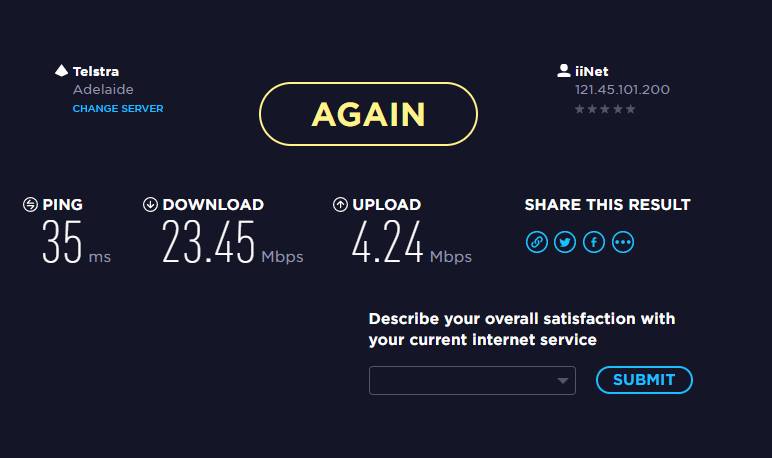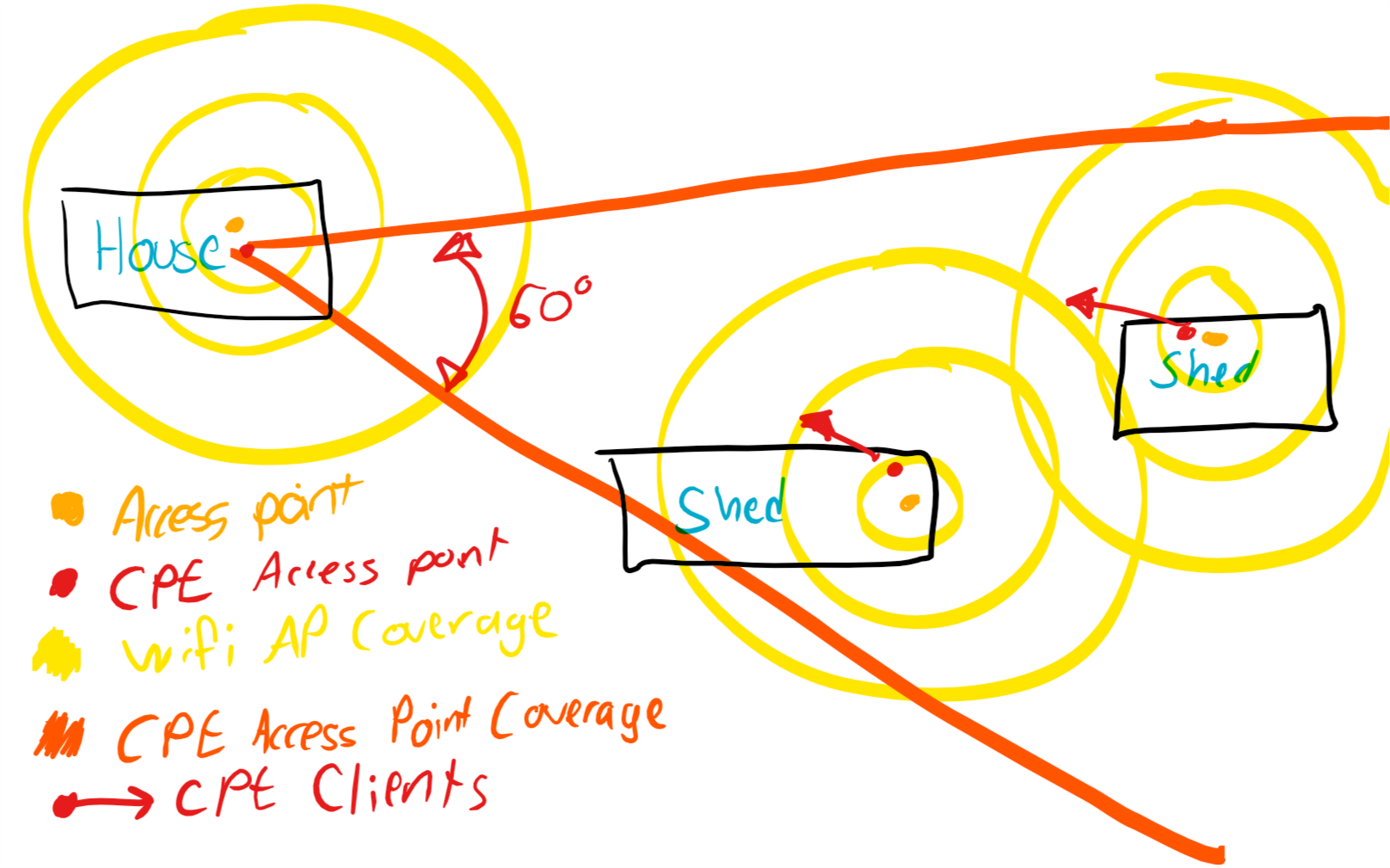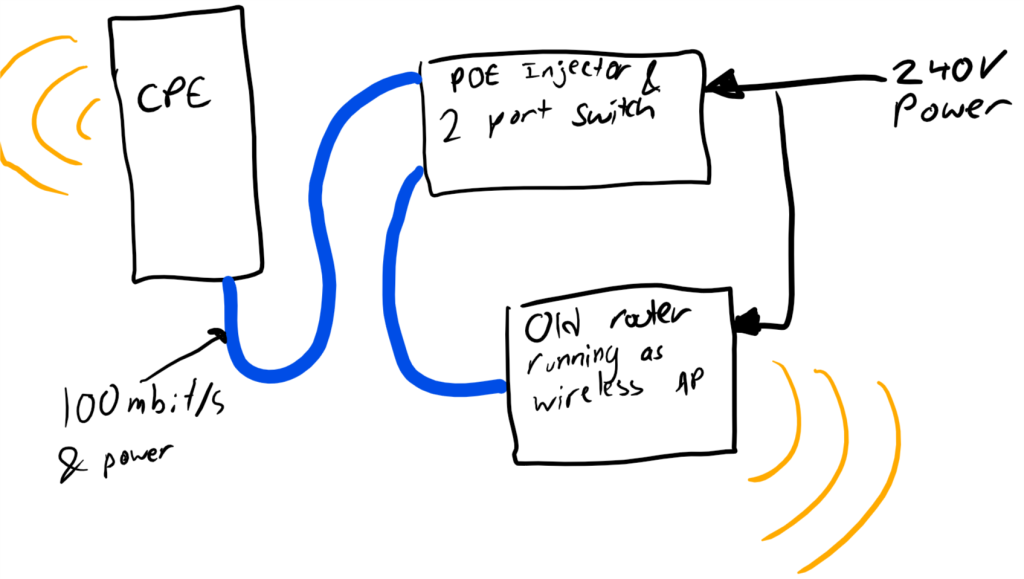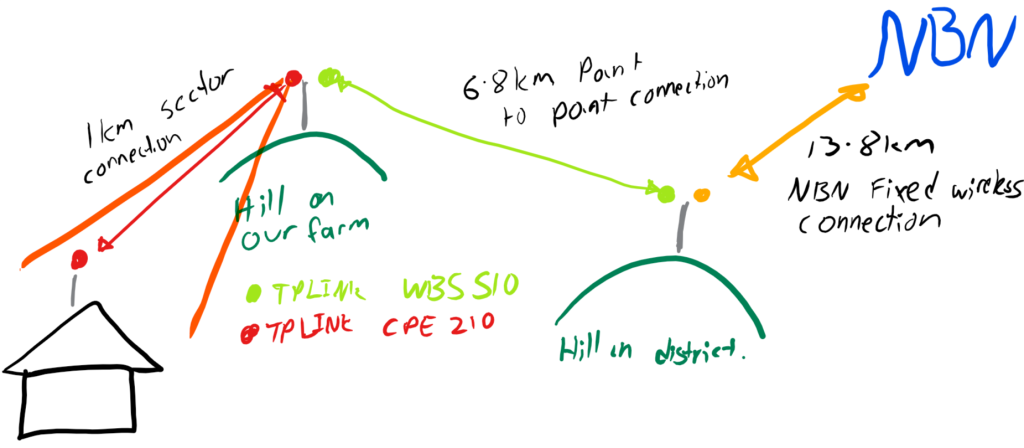When the NBN fixed wireless was announced, I was excited because I thought our farm would finally get a decent internet connection but my excitement was quickly put to rest when I realised that our house would fall 7km short. “You can be serviced with sky muster” says NBN but sky muster is terrible. High latency (property of all satellite connections), low bandwidth, low monthly data allowance. I had to find another way to get internet and last week I did it!
The back story
In 2016 I wanted to get a wireless network to a couple of our sheds on our farm. They were about 50-100m from our house and too far for normal wifi (when considering the absorption of the shed walls) and I wasn’t keen on the idea of trenching cables to them. I started searching and found the TP-LINK Customer Premises Equipment (CPE) devices. These gave reasonably directional wifi access points and claimed ranges up to 13km. Considering I needed to make a 100m link, I thought it should work – and it did.
The network switch in our house ran into a power over Ethernet (POE) injector that powered and gave data to the CPE on the roof of our house that looked towards the sheds. The house roof CPE runs in AP mode where it broadcasts an SSID for other devices to connect to. The shed CPEs run in client mode where they just connect to a SSID they can see. They can pretty much only see the house one. From there the shed CPEs are connected to old routers which run as a switch and AP to clients in the area.
The sheds are set up like so. The POE injector limits the Ethernet speed to 100mbit/s despite the max potential WiFi link speed being 300mbit/s
Bringing the NBN to our farm.
Now that I knew links like this were possible, I started to wonder “could I get fixed wireless NBN installed remotely and send the connection back home?”
The first challenge was finding a suitable install location. I found out that NBN has a fixed wireless range of 14km before they stop servicing. I used their coverage maps and google earth to find a location on a hill somewhere in the district that our farm could see where the NBN could potentially be installed. Unfortunately, that location couldn’t be seen by our house so a second link was needed up on our tallest hill.
I made the point to point link with two TP-LINK WBS510 with 30dbi gain dish antennas. Something to note with these products is that while they claim 300mbit/s and 50km range, it’s one or the other. At nearly 7km, point to point link gets a steady 100mbit/s over the wireless which is perfect for my use case but the speed will have to be set slower if the distance increases to increase the stability of the connection. If you’re only aiming to get a 25mbit/s connection from the fixed wireless, then your link speed needs to only run a bit faster than 25mbit/s. NBN apparently has plans for 100mbit/s fixed wireless connections in the future so I was happy to know I could carry that speed all the way home.
Most hills don’t have a power supply
But they do get sunshine! The next part of the plan is to power these links and for that I used a 230AH AGM deep cycle battery, a 250W 12V solar panel from eBay and a charge regulator form ebay. These were all mounted inside an IP67 electrical box. I then designed and constructed a pole to mount all of this on.

The tower for the farm. The box is smaller as it was one we already had but this one is missing the dish in the drawing as it was a later retrofit.

The station on our farm built but missing the dish that was later added for a stronger point to point link.
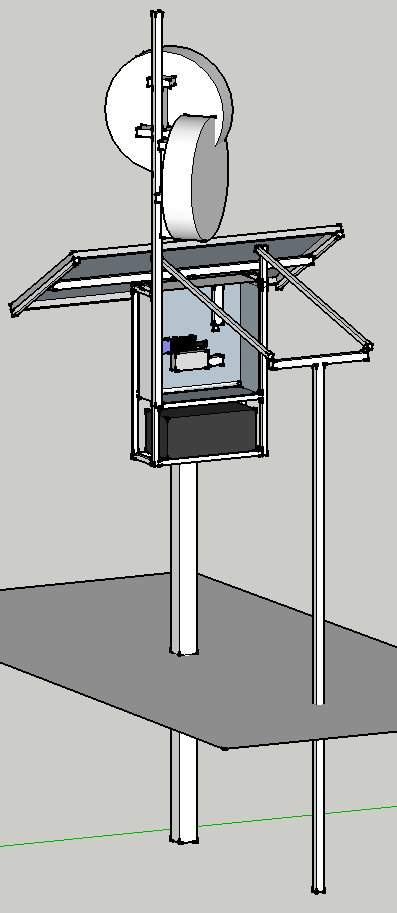
The tower where the NBN installed their connection. In SA, the antenna mast supplier will only allow installs to “roof structures” so one was retrofitted. This one includes two dishes because this station will service two homes.
Challenges
Keeping the box cool is a worry of mine for summer time. The inverter inside the box will cut off at 60 degrees celcius and we often have days where the outside air temperature is above 40 degrees. Add some sunshine to that mix and you’ve got a hot box. To prevent this, I’ve added a layer of corrugated iron to shield the incoming light and add a path for air to channel through. I’m hoping this will keep the box cool enough during the day but I’m pessimistic at the moment. If it does overheat, the solution is a intake fan with dust filter on the bottom and a exhaust vent. Both are easy to retrofit, but add their own problems like moisture condensation on the internals. I’ll cross that bridge in the summer.
I love birds but they are a nuisance when it comes to wires. If a bird can perch and chew a wire, then that wire WILL be chewed. It’s only a matter of time. The solution is either stop the perching or remove the ability to chew. I ended up with both. My wires come up a metal pole and out to the devices but I once had my wires chewed off in the small 6cm gap between the pole and device. I’ve since installed bird spikes to prevent perching and wrapped all the wires in conduit. This was particularly important to the NBN install as it was left in a state that birds would have destroyed in only a few days if I hadn’t covered it up. It’s a big problem when you consider it takes them a few weeks before they can come out and see you.
Sizing the solar panels and battery for fully autonomous use was challenging. It was a matter of working out the power use (about 10w for each CPE and NBN connection) and from there I aimed for a battery which would give 3 days of autonomy. Once I had that, I worked out the size of the panel I would need to make sure the battery could be fully charged on an average day in South Australia. That came to about 250W. I then looked at the best all year round angle for power generation. At our latitude, it’s 30 degrees from horizontal. So far, everything has been working fine and the battery hasn’t once gone flat but in hindsight it isn’t the best line of thinking. Our summer time is dry and has many sunlight hours so there’s no point considering the battery going flat then. Winter on the other hand has shorter days and more cloud cover. It would have been smarter to angle the panel for optimal winter power generation and size the panel such that it can still charge itself in full cloud cover. At the moment, the rough calculation is that it will only just charge itself so we should be fine.
Getting internet goes through layers of contractors. I want an installer to come and hook up my station. The installers listen to commands from the SA manager of the NBN. The NBN listens to commands from the Internet Service Provider (ISP). the ISP listens to me except the ISP can’t request an install at a location where the NBN doesn’t think it can be done. I knew the connection could be made because I was in range and had full LOS for all the links. It’s just a matter of convincing the person on the phone in an office that street addresses don’t mean much in rural areas and that GPS coordinates are better. I ended up installing as if I was the owner of the property of the install location and had to convince the ISP that there was a missing address or the address is wrong and then get them to submit a request to NBN to update the address location (which by default is the driveway) to the location the install will go ahead at.
The end result
My links are now rock solid and work as intended. Occasionally the internet slows right down to 1-3mbit/s for 5 mins and goes back to full speed again. I’m not exactly sure what causes this issue but I think it’s the NBN link. I’ll have to investigate that further.

